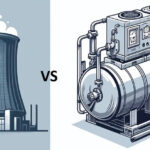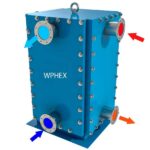Helical coil heat exchanger is widely used in various industrial processes for heat transfer between two fluids. The helical coil design allows for a large heat transfer area in a relatively small space, making it an efficient and compact solution for heat exchange applications. This type of heat exchanger uses a continuous spiral shape to transfer heat between two fluids. We will discuss briefly their usage and applications as well as their advantages and disadvantages.
Usage and applications
Here are some common usage and applications:
- Chemical processing: They are commonly used in the chemical industry for various processes such as heating, cooling, condensing, and evaporating fluids. They can handle a wide range of fluids, including corrosive and high-viscosity liquids.
- HVAC: They are also used in air conditioning and refrigeration systems for both heating and cooling. They can efficiently transfer heat between the refrigerant and the air, providing a comfortable indoor environment.
- Power generation: Helical coil heat exchangers are used in power plants to transfer heat between the hot exhaust gases and the water, producing steam that can be used to generate electricity.
- Food and beverage processing: Helical coil heat exchangers are used in the food and beverage industry for various processes such as pasteurization, sterilization, and cooling. They can handle high-viscosity fluids and delicate food products.
- Oil and gas processing: Helical coil heat exchangers are used in the oil and gas industry for various processes such as crude oil heating and cooling, gas processing, and natural gas liquefaction.
Advantages
The main advantages include
- Compact design: Due to its compact and spiralled design, helical coil heat exchangers can be used in limited spaces.
- High heat transfer efficiency: Helical coil heat exchangers have a high surface area to volume ratio, which results in a high heat transfer coefficient and efficient heat transfer.
- Low pressure drop: The smooth and continuous flow path of the helical coil design minimizes pressure drop, which reduces energy consumption and improves efficiency.
- Versatility: Helical coil heat exchangers can handle a wide range of fluid temperatures, pressures, and flow rates, making them suitable for a variety of applications.
Disadvantages
The main disadvantages includes:
- Complex design: The spiralled design of helical coil heat exchangers can be complex and difficult to manufacture, requiring specialized equipment and expertise.
- Limited size: The compact design of helical coil heat exchangers can also limit their size and capacity.
- Higher cost: The specialized manufacturing and materials required for helical coil heat exchangers can make them more expensive compared to other types of heat exchangers.
Summary
Helical coil heat exchangers are a versatile and efficient option for heat transfer applications, but the complexity of their design and higher cost compared to other types of heat exchangers must be considered when making a decision. They can handle a wide range of fluids and are ideal for processes that require a high degree of heat transfer in a relatively small space.
| Advantages | Disadvantages |
|---|---|
| Compact design | Complex design |
| High heat transfer efficiency | Limited size |
| Low pressure drop | Higher cost |
| Versatility |
Useful software
Helical coil heat exchanger design – Thermal design calculations and sizing.











